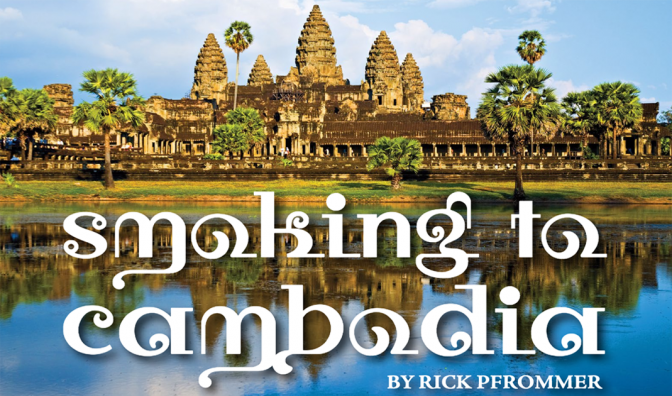Smoking to Cambodia

Known for its white-sand beaches, ancient temples, roaring rivers and soaring mountains, Cambodia is also rich in cannabis culture. For centuries, the country—originally called Khmer or Kampuchea—was fought over like a scrap of meat. From China to the North, Siam (now Thailand) to the West and Vietnam to the East, the Khmer empire was under constant threat from foreign opportunists. Amazingly, the Cambodian people were able to endure and maintain their rich culture.
From 1968–1972, the U.S. illegally carpet-bombed Eastern Cambodia as part of the expanded Vietnam War. During three years of aerial assaults, many residents fled their homes in the countryside and sought the relative safety of the cities.
Even after the devastation of the Vietnam War, Cambodians could not have imagined the horrors that were about to unfold. The Khmer Rouge, led by Pol Pot, took over the country in 1975 with the goal of creating a revolutionary socialist state. They abolished money, and shipped all city dwellers to the country to work. Anyone who was educated—teachers, artists, intellectuals—was immediately sent to a camp. Soon the genocide began: Over the next three years, the Khmer Rouge killed more than three million people, or a quarter of the entire Cambodian population (as portrayed in The Killing Fields).
Forty years later, Cambodia is once again on the world tourist circuit. The temples at Angkor Wat are considered among the greatest ruins in the world. The country’s natural wonders are world-class: primeval rainforests, the mighty Mekong River (one of the world’s largest) and mountains filled with bears, crocodiles, tigers and many newly discovered animal species.

Cambodia’s Southeastern coast—it’s only coastline—is famous for two crops: Kampot peppers and cannabis. The marijuana grown in Kampot is exclusively sativa, as one would expect in Southeast Asia. The loose, immature lower grades available have no real calyx structure and contain seeds; they tend to be electric-green in color, with lots of red hairs. Surprisingly, though, some are real creepers, and a half hour or so after smoking you’ll be spacing out on the ocean or the rustle of the coconut palms. The seedless higher grades are more developed, with fully formed calyx structures and beautiful golden tones, with some red hairs, too.
Prices vary wildly. The local tuk-tuk taxis are motorcycle-powered vehicles with carriages attached, and some drivers sell five-gram bags of herb for $20; they might start by asking for $40 or more, but after a quick refusal, they rapidly drop their price. Sihanoukville, near Kampot, is a tourist mecca; it’s right on the beach, and full of bars and other attractions. The town itself is a little grungy, and crawling with young backpackers drinking buckets of liquor every night.
About a mile out of town is the real scene. The beaches of Otres are magical places. Otres Beach 1 is a quarter-mile strip with little bungalows and dorms bearing names like Last Hippie Standing and Mushroom Point (where all the bungalows are shaped like magic ’shrooms). Several of the bars sell grass, hash and edibles right over the counter; both local hash and imports are available. The town is teeming with hippie types, so finding even cheaper accommodations is not hard. Plus, there’s a rave party every week out in the jungle.
Over on Otres Beach 2, hippies are colonizing the little village. Folks have set up teepees, and sell larger amounts of herb pretty openly. Some are even starting to work with local farmers to teach them more modern weed cultivation techniques.
This all truly seems like paradise, and it is pretty sweet—for now. The international backpacker community is firmly ensconced there, and many expats own businesses. However, anyone with a business within 250 feet from the beach will soon need to vacate, the Cambodian press has reported; the stated reason is that the buildings are too close to the ocean, which has an environmental impact. The owners are working closely with local politicians to prevent this from happening. Only time will tell, so go now while you can smoke a spliff of some fine Cambodian sativa and watch the sun slowly slide into the Pacific.
If you enjoyed this Freedom Leaf article, consider subscribing today!

